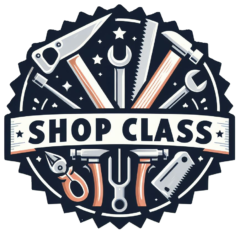The Leopold bench is an ideal first project for beginning woodworkers or DIY’ers. The joinery is straightforward with no complex layouts or cuts and can easily be built in an afternoon. It will teach you how to lay out a project, make the cuts, and assemble the project. You have options on finishing (leave it raw, paint, or a penetrating oil). Further, it is a very useful bench to have around your house.
With only 4 boards you can build two benches. Further, you can cut the boards in half at the store and transport them home in almost any car.
Tools Required
Saw – circular is best and what this project is designed for. However, a jigsaw or hand saw will work as well.
Steps:
Making the cuts
Buy one 10′ – 2″x10″, two 10′ – 2″x8″, and one 10′ – 2″x6″ boards. Pick the straightest ones you can find, look for #1 grade. If you can transport 10′ boards, you can break them down at home. Otherwise, cut them in half in the store or the parking lot. Some stores offer a method to cut down lumber. Options for cutting it yourself in the parking lot are using a battery-operated saw or a hand saw.
Cut two pieces of the 2″x10″ to 57″ for the seats and two pieces of the 2″x6″ to 60″ for the backs. Make sure to cut the ends square so the joint will be square when assembling the bench. The factory edge might not be square so it is better to trim each edge. Following the diagram cut the 4 leg pieces.
Now would be a good time to sand all the pieces to remove any mill marks, rough spots, or splinters.
Assembling The Legs
The most important thing to remember when assembling the legs is they are mirror images of each other. The next most important is that the bottom of the legs are in a straight line so that the bench is stable and does not rock.
Use the board for the back to align the bottoms of the legs. Then fasten them together with either 3 carriage bolts or glue and screws.
Attach The Seat & Back
Wood screws and glue are used to attach the seat and back. Center the seat on the leg and align the back with the top of the long leg.
Finishing
If you want to round over the edges it will make the bench more comfortable to the touch. The boards already have a small round-over on the factory edges, where you cut them it will have a sharp edge. Sandpaper or a router can be used to knock down the edges.
You could leave the wood raw, but it will last longer if painted or you apply a penetrating oil finish.
Options
You can make the bench any length you want, just cut the seat 3″ shorter than the back. About 6′ is the practical length, if it gets too long it will sag.
The length of the shorter leg determines the seat height. If you find a taller or shorter seat height more comfortable then adjusting the shorter leg will change the seat height.
